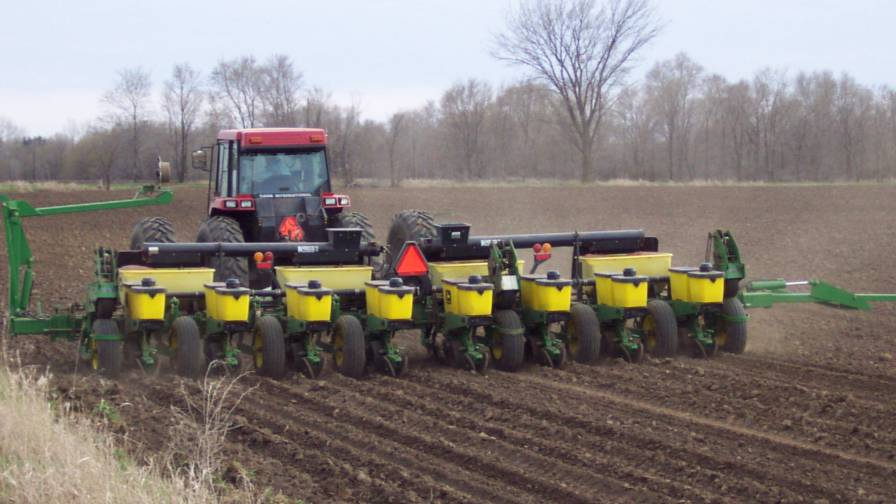by Matt Leavitt, Organic Lead/Agronomist & Margaret Smith, PhD, Forage Agronomist
We’ve had more than a few calls in the past week about folks planting organic corn. The temptation is real: the calendar says spring, temperatures are favorable, the soil is drying, the neighbors are rolling, and the itch to get the planters in the field can be strong. Hearing that farmers are planting organic corn at the same time as conventional corn makes us nervous for more than a few reasons.
Our general rules of organic corn planting are to:
- Delay planting two to three weeks after conventional corn has been planted to allow soils to warm.
- Plant with favorable weather in the forecast.
Why Wait to Plant Organic Corn?
Temperature Controls Corn Emergence
Corn germination and emergence is greatly affected by soil temperatures and moisture. Corn takes about 100 to 120 accumulated Growing Degree Days (GDD-Base 50) or heat units, from the time of planting to emergence. As spring progresses and days warm, greater numbers of GDDs are accumulated. For this reason, corn emerges quicker when planted later in spring. In a Minnesota experiment, conventional corn emerged in 25 days when planted April 15, but in only nine days when planting on May 10.
Graph from Organic Risk Management Guide, UMN
To track growing degree day accumulations, you can access an official weather station near your farm at the following websites:
Soil temperatures of 50°F and upwards is the accepted threshold for planting conventional corn. Corn hybrids are more cold-tolerant than in the past, but fungicide and insecticide seed treatments—which are not approved for organic agriculture—are the biggest reasons why corn planting can be pushed earlier. Organic corn needs warmer soil temperatures for rapid germination and emergence.
Plant Population
The most important reason to delay planting organic corn is the risk of a poor stand. Corn seed that sits in cool, moist ground for five days or more is subject to insect feeding and fungal seed rots, which can reduce corn plant populations. Current OMRI-approved organic seed coatings are not equivalent to chemical fungicides/insecticides. Organic coatings like SabrEx and Soil Biotics 1r have no activity on pythium, fusarium, or rhizoctonia soil-borne fungal diseases or on seed-eating insects such as seed corn maggot and wireworms. These seed coatings are to enhance crop growth once plants have emerged.
Ideally, organic corn should emerge in four to five days after planting to avoid seed rot and insect feeding. To achieve that, soil temperatures need to be at 55°F or higher at a 4” depth and GDDs accumulating at a rate of 20 to 25 units each day.
Ray Yokiel has developed his own temperature guidelines for his southern Minnesota organic farm.
I like the soil temperature at a 3” depth to be at 50°F at 7 a.m. for two days in a row, and then I want a favorable five-day forecast.Ray Yokiel of Wells, Minnesota
To track soil temperatures, check these websites:
- Minnesota
- Iowa
- North Dakota
Weed Management
A poor stand of corn, or one with delayed or uneven emergence, hurts you in more ways than just yield potential: it leaves open space for weeds to establish, mature, and set seed. Delayed emergence allows time for weed species, such as velvetleaf and Giant ragweed, to ‘get a jump’ on your corn, especially if a rainy period prevents tine weeding or rotary hoeing. It also impacts timely row cultivation and it can make cultivation less effective. Extra or delayed passes (plus the potential expense of replanting) are expensive!
Optimum weed control depends on even stands of corn for early season control, which is more effective than later cultivation passes. In addition, later planting dates allow you to do several full-width weed control passes before you plant, which leads to better in-season control.
Avoiding Pollen Contamination
Another good reason to delay organic corn planting is to avoid pollen contamination. Organic corn emerging and pollinating at the same time as conventional corn is subject to potential cross-pollination with GMO pollen. Corn pollen travels far and wide and can be viable for over a mile or more. Organic corn can, and has been, rejected for elevated GMO levels. Nothing is more painful than having to turn around a truck at the elevator or having a load rejected. One of the safest ways to prevent corn from being cross-pollinated with GMO pollen is to stagger your plantings from your conventional neighbors.
The Take-Away Message
- Plant organic corn into warm soil, about 55°F daily average at a 4” depth, and with a future forecast of warm air and soil temperatures for at least five days after planting.
- These conditions are typically met about May 15 in southern Minnesota.
- Planting organic corn into warm soil followed by cold, wet conditions will likely result in a poor stand and replanting.
- In general, plant organic corn two to three weeks after your conventional neighbors.
- Choose earlier maturing hybrids (5 – 10 RM) than those planted by conventional farmers in your area.
- Plant organic corn at the optimum depth of 1.75” to 2’’ deep in moisture (slightly deeper to 2.5’’ if soils are dry).
- If conditions result in a poor plant stand, you may be better off replanting.
If you experience emergence issues, our on-staff agronomists can help you evaluate your corn stand and think through the possible next steps. Give us a call at 800-352-5247.
Resources
Corn requires Favorable Soil Temperature for Uniform Germination, George Silva, University of Michigan
Relative Emergence Sequence for Weeds of Corn and Soybeans, Bob Hartzler, Iowa State University
The Emergence Process in Corn, Bob Neilsen, Purdue University, Indiana

